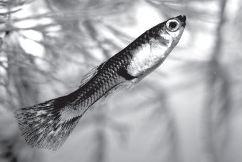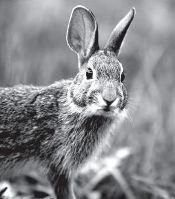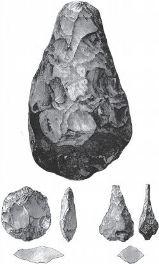The Beginning of Ego
Ashlag’s words quoted above mark a turning point not just in the history of human evolution, but in the evolution of the universe, as well. The (uniquely human) evolution-by-envy has shifted the very direction of evolution. Until the emergence of human ego, creatures evolved successfully if their internal organs cooperated, following the principle of relinquishing self-interest in favor of the system’s interest, and leaving the system to care for their well-being.
Yet, it is important to note that the rule of Relinquishment of Self-interest in favor of the interest of the system applies not only to organs and tissues within a creature. Organisms do not exist in vacuum; they are branches, as we said in the previous chapter, of roots that appeared in the spiritual realm. For this reason, they operate in the same way that spiritual systems operate—yielding self-interest before the interest of the host system—or succinctly: altruistically. Their host system—the ecosystems in which organisms live—abide by the same rule, since no other rule enables life to perpetuate.
For this reason, the rule of yielding self interest we have been mentioning throughout the book applies just as rigorously to the creature’s functionality within its environment. Thus, if a creature’s physique works fine under certain environmental conditions, but conditions change, this creature’s physique might become inadequate and even inferior to that of creatures with a less sustainable internal structure, yet higher adaptability to their environments.
Apparently, such was the case with the extinction of dinosaurs. For 165 million years, dinosaurs ruled the earth, but approximately 65 million years ago, they disappeared within a relatively short time. Theories as to the reason for their disappearance abound, but no conclusive answer has been found.
One possibility is the meteorite theory. According to the U.S. Geological Survey (USGS), “There is now widespread evidence that a meteorite impact was at least the partial cause for this extinction.” [82] But while there is no scientific consensus around a meteorite impact being the cause, there is indeed consensus that, as published by the University of California Museum of Paleontology, “There was global climatic change; the environment changed from a warm, mild one in the Mesozoic era [era of dinosaurs] to a cooler, more varied one in the Cenozoic era [era of mammals].” [83]
Thus, whether it was a meteorite or something else that changed the climate, there was an abrupt change of environment to which dinosaurs (and approximately fifty percent of the species living on earth at the time) could not adapt. And so, they became extinct.
To survive, dinosaurs and almost all other animals must abide by the same law regarding their environment as their internal organs do: yielding self-interest in favor of the system’s interest, in return for the system’s care for them. When the rule is breached in the entire ecosystem, even if not willfully on the part of the animals, extinction occurs on a colossal scale simply because they did not adapt quickly enough.
A more recent, and far more successful example of animal adaptation to changing circumstances was reported by Swanne Gordon of the University of California in an essay titled, “Evolution Can Occur in Less Than Ten Years,” published on Science Daily. “Gordon and her colleagues studied guppies—small fresh-water fish (Image no. 4) biologists have studied for long. They introduced the guppies into the nearby Damier River, in a section above a barrier waterfall that excluded all predators. The guppies and their descendents also colonized the lower portion of the stream, below the barrier waterfall, that contained natural predators. Eight years later…, the researchers found that the guppies in the low-predation environment… had adapted to their new environment by producing larger and fewer offspring with each reproductive cycle. No such adaptation was seen in the guppies that colonized the high-predation environment… ‘High-predation females invest more resources into current reproduction because a high rate of mortality, driven by predators, means these females may not get another chance to reproduce,’ explained Gordon. ‘Low-predation females, on the other hand, produce larger embryos because the larger babies are more competitive in the resource-limited environments typical of low-predation sites. Moreover, low-predation females produce fewer embryos not only because they have larger embryos but also because they invest fewer resources in current reproduction.’” [84]
Image no. 4: Trinidad Guppy,
the type used for the Damier River expermiment
(Image: Photobank Lori)
In some cases, when required in order to increase their chances of survival, organisms (albeit only a virus in this case) may even “devolve” themselves. Such was the case with the Myxoma virus and the European rabbits in Australia (Image no. 5). Some 150 years ago, two dozen rabbits were released to the wild in Australia in the hope that they would reproduce enough to be hunted for sport. But the rabbits reproduced so successfully that within a few decades, they threatened to disrupt the wildlife equilibrium in the entire Australian continent. Wendy Zukerman, a reporter for New Scientist Magazine, published a detailed description of the episode on ABC Science. In her report, she writes, “By the 1920s, Australia's rabbit population had swelled to 10 billion.” [85]
Image no. 5: European Rabbit in Australia
(Image: Photobank Lori)
Australian authorities made vigorous attempts to quell the rabbit population, but not until 1950 were they successful. In that year, continues Zukerman, “The biological control agent, Myxoma virus, was introduced to Australia's mainland.” [86] As a result, “Myxomatosis [the disease caused by the virus] caused enormous reductions in rabbit numbers. In some areas 99 per cent of the rabbits were killed.” [87]
But instead of extinguishing the European rabbits in Australia, their population gradually stabilized and even rebounded in some areas. Clearly, the virus had become less effective. When researchers looked into the reason for the virus’ diminished impact, they discovered that it had mutated into a milder form that killed only 40 per cent of rabbits infected. Thus, researchers concluded, because the virus’ only hosts were rabbits, it mutated into a less aggressive type, which guaranteed the survival of the rabbits, and as a result, the persistence of the virus, as well.
By weakening itself, the virus seemingly acted against its own interest, giving the rabbits’ immune systems a better chance at fighting it. But the actual result of its self-induced weakening was the assurance that it would have a host in which to dwell for generations to come. Indeed, to this day, myxomatosis is responsible for many deaths among rabbits, but not enough to altogether extinguish them. It seems as though rabbit and virus have achieved equilibrium, and hence co-existence.
Man—the Only Exception
In the previous section, we saw how the rule of Yielding Self-interest in favor of the system’s interest in return for the system’s care, applies not only to all organisms, but also to the organism’s functionality within its habitat (ecosystem). Yet, there is one exception to the rule: man. To understand why man is different from all other animals, we need to reflect on the four stages. Stages One through Three reflect desires to receive pleasure from a giver, either by receiving pleasure directly from it or by returning its pleasure. But Stage Four is essentially different: it reflects a desire to be the giver.
Put differently, Stage Four wishes to attain a goal that is, by definition, unattainable. Just as a son cannot be his father, Stage Four cannot be Stage Zero. But just as a son can be like his father, Stage Four can be like Stage Zero.
Being a desire to receive, and knowing that being like Stage Zero, the Root, is the highest possible reward, this is what Stage Four wishes to achieve. As a result, we—its corporeal personification—strive to achieve the same. Subconsciously, our desires for fame, power, wealth, erudition, and immortality are really desires to become godlike. No person escapes these desires, since we are all parts of Stage Four, which was broken along with Adam's soul. The only variations among humans are in the intensity and proportion of these desires, but not in their components.
Evidently, there are people whose desires for fame, fortune, and brilliance are very small—these are simple folk content with shelter, family, and very basic sustenance. In such people, the desires of Stage Four are less dominant; hence, they will have less ambitious goals. But even in the most sedate individual there is a “devil” that wishes for a little more than one’s neighbor possesses. These are the desires of Stage Four—the sense of entitlement that Twenge and Campbell write about—and they are almost uniquely human.
These desires are also what make us the exception to the rule that governed evolution until the emergence of Homo sapiens. Because humans possess an innate aspiration to become like the Creator, we tend to be active in our approach to challenges, rather than passively adapting to conditions, as do other animals. Hence, instead of adapting our bodies as best we can to changing climates or to threats, we try to change the climate or to eliminate the threats.
One such effort was changing our “personal microclimate,” our immediate surroundings, by covering our skins with those of animals, whose fur provided better protection against the elements than our own. And instead of relying on our (clearly insufficient) physical strength to catch our food, we developed increasingly sophisticated tools to assist us in hunting, as well as for protecting ourselves against prey animals. Today there is unequivocal evidence that primates, some mammals, and even birds use tools such as rocks, twigs, and branches to assist them in acquiring food and in fighting. But systematic tool and weapon production, such as carving stones and bones into spears, is a uniquely human ability (Image no. 6).
Image no. 6: Hand axes from Kent (England),
made during the Lower Paleolithic period (Old Stone Age),
2.5 million – 200 thousand years ago.
Another very important discovery that early humans (Homo erectus) made was the control of fire. Fire allowed humans to keep their habitat warm, deter prey animals, and even cook. The discovery of ways to make and to control fire marks a dramatic shift in evolution. Man was now an animal that could change its environment to fit its needs, instead of having to change itself to fit the environment.
According to a document titled, “The Great Ice Age,” released by the U.S. Geological Survey, “The Great Ice Age ... began about a million or more years ago.” [88] The vast ice sheets allowed humans to migrate from Africa and to gradually spread all over the world. With fire and clothing, they could sustain themselves in less hospitable climates and thus became the most adaptable and ubiquitous mammal on earth.
Body vs. Mind
A deeper and far more important aspect of the shift in evolution that the appearance of man represents is that unlike other animals that develop their bodies, humans develop their minds. To cope with danger or to obtain food, animals try to outrun or outfight their attackers or prey.
Humans, instead, build weapons. To cope against the cold, animals grow thick fur and layers of hypodermal fat. Humans light fires.
The use of the intellect instead of the body to obtain desirables also allows humans to plan ahead. While some animals store food for the winter, only humans grow food and clear unwanted vegetation from the land to make room for plants that serve them as food. According to most researchers, agriculture began between 10,000 and 15,000 years ago in the Fertile Crescent (although new data collected by a team led by Dr Robin Allaby from the University of Warwick has found evidence that plant agriculture began in Syria as early as 23,000 years ago) [89].
Although man’s ability to grow food may seem much ado about nothing today, when humans first began to cultivate land, they, in a sense, became creators—they began to change their environment. This is a feat that only a desire of Stage Four can conceive.
Yet, with progress comes problems. All creatures, except man, must adhere to the rules of their ecosystem or they will perish. Man is the only organism that can plan and execute change in its environment at will. When this happens, man must learn the rules by which ecosystems work, or the changes might prove to be disastrous to the ecosystem, and by consequence, to its inhabitants, man included.
In Chapter 4, we said that in the human body, as in any organism, each cell has a particular role. Also, we wrote, “For the organism to persist, each cell must perform its function… and yield the goal of maintaining its own life before the goal of maintaining the life of its host organism. If a cell begins to act contrary to that principle, its interests will soon clash with those of the body and the body’s defense mechanisms will… destroy it.”
Similarly, when man became potent enough to alter his eco-system, he had to learn how to behave like a cell in an organism—refraining from jeopardizing the system’s sustainability, and risk having the system need to rid itself of the danger by either eradicating the human race altogether or by dying itself, killing the human race in the process, as described in regard to cancer. Today, I believe it is quite evident that Nature is already “taking compensatory measures” to balance humans’ detrimental actions.
But ten or so millennia ago, things were very different than they are now. Homo sapiens were just beginning to enjoy the benefits of knowledge and technology and the concept of humans risking their habitat was not on anyone’s mind. The development of agriculture shifted people’s lifestyles from hunting and gathering to a more sedentary comport, one consequence of which was the acceleration of technological development.
Another important issue that was on people’s minds at that time (and still is for many) was religion. Prof. Jared Diamond, acclaimed author of Guns, Germs, and Steel: The Fates of Human Societies [90], said in a lecture titled, “The Evolution of Religions” at University of Southern California [91], that approximately ten and a half thousand years ago, religion changed its functions. He explained that religion had adopted a role of explaining things. Religion began to explain all that was unknown and unfamiliar, and thus provided solace and confidence to people.
But the important thing to note about religion at that point is not so much the direction in which it developed, but the very fact that it developed. The existence of an institutionalized, organized entity that provided answers meant that people were beginning to ask questions—profound questions about the purpose of life and the laws that govern it. This later prompted the emergence of Kabbalah, precisely in that same area—the Fertile Crescent—as we saw in Chapter 1.
In addition to the evolution of religion, because the agricultural advances we just mentioned encouraged people to abandon their nomadic lifestyles for a more sedentary one, the population in the Fertile Crescent began to grow. And when technological developments, such as the invention of the wheel, encouraged further development and urbanization, more organized forms of government and religion ensued. Thus, Mesopotamia gradually became what we now call “The Cradle of Civilization.”
[82] United States Geological Survey (USGS), “Why did the dinosaurs die out?” (May 17, 2001), http://pubs.usgs.gov/gip/dinosaurs/die.html
[83] University of California Museum of Paleontology, “What Killed The Dinosaurs?” (January 2009), http://www.ucmp.berkeley.edu/diapsids/extinctheory.html
[84] “Evolution Can Occur in Less Than Ten Years,” Science Daily (June 15, 2009), http://www.sciencedaily.com/releases/2009/06/090610185526.htm
[85] Wendy Zukerman, Australia's battle with the bunny, ABC Science (April 08, 2009), http://www.abc.net.au/science/articles/2009/04/08/2538860.htm
[86] (ibid.)
[87] (ibid.)
[88] Louis L. Ray, “The Great Ice Age,” U.S. Geological Survey (September 27, 1999), http://pubs.usgs.gov/gip/ice_age/ice_age.pdf
[89] Robin Allaby, “Research pushes back history of crop development 10,000 years,” University of Warwick (September 19, 2008), http://www2.warwick.ac.uk/newsandevents/pressreleases/research_pushes_back/
[90] Jared Diamond, Guns, Germs, and Steel: The Fates of Human Societies (NY: Norton & Company, 1997)
[91] Jared Diamond, “The Evolution of Religions” (Uploaded by Rabid Ape, May 26, 2009), http://www.youtube.com/watch?v=GWXr7pXoCTs



